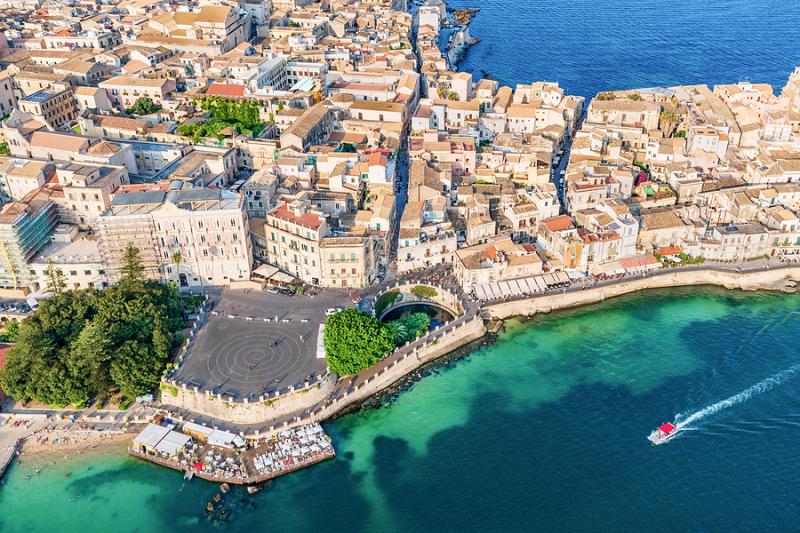Unesco Sites of Italy: Syracuse and the Rocky Necropolis of Pantalica
ITA:

This Unesco World Heritage site, inscribed in 2005, comprises the ancient city of Syracuse in south-eastern Sicily and the nearby Necropolis of Pantalica.
Syracuse was founded in the 8th century BC by Greek colonists from Corinth on the small island of Ortigia, site of the Arethusa fresh water spring, which inspired myths and poems. Four more neighborhoods were developed later around Ortigia, and Syracuse soon became one of the leading cities of the ancient Mediterranean.
Cicero described it as ‘the greatest Greek city and the most beautiful of all’.
Many buildings and well-preserved architectural structures testify to the many different rulers of Syracuse, including the Romans, Byzantines, Arabs, Normans, Frederick II of the Hohenstaufen dynasty (1197–1250), the Aragons, the Bourbons.
These beautiful vestiges - which include the Temple of Athena (5th century BC, later transformed to serve as a church and rebuilt as a Baroque cathedral, in the late 17th century); traces of the temple of Apollo made in Doric style, the most ancient in Western Greece (6th century B.C.); a Greek theatre, a Roman amphitheater, the Tomb of Archimedes, a fort and more - reveal the importance that Syracuse had for almost 3,000 years in the Mediterranean area.
This world heritage site also includes the rocky Necropolis of Pantalica, 40 kilometers from Syracuse; it contains more than 5,000 tombs cut into the rock near open stone quarries, most of them dating from the 13th to 7th centuries BC.
According to researchers, Pantalica was an indigenous state that flourished prior to Greek colonization. With the growing influence of Syracuse, the settlement and the necropolis were abandoned.
“Syracuse offers a unique testimony to the development of Mediterranean civilization over three millennia,” writes Unesco.
Questo sito Patrimonio dell'Umanità Unesco, inserito in lista nel 2005, comprende l'antica città di Siracusa nella Sicilia sud-orientale e la vicina Necropoli di Pantalica.
Siracusa fu fondata nell'VIII° secolo a.C. da coloni greci provenienti da Corinto sulla piccola isola di Ortigia, dove si trovava la sorgente di acqua dolce ‘Aretusa’, che ispirò miti e poesie. Altri quattro quartieri si svilupparono in seguito intorno ad Ortigia e Siracusa divenne presto una delle principali città dell'antico Mediterraneo.
Cicerone la descrisse come "la più grande città greca e la più bella di tutte".
Molti edifici e strutture architettoniche ben conservate testimoniano i molti diversi dominatori che si avvicendarono a Siracusa, tra cui romani, bizantini, arabi, normanni, Federico II della dinastia degli Hohenstaufen (1197–1250), aragonesi, borbonici.
Queste belle vestigia - che includono il Tempio di Atena (V° secolo aC, successivamente trasformato in chiesa e ricostruito come cattedrale barocca alla fine del XVII° secolo); tracce del tempio di Apollo in stile dorico, il più antico della Grecia occidentale (VI° secolo a.C.); un teatro greco, un anfiteatro romano, la tomba di Archimede, un forte e altro - rivelano l'importanza che Siracusa ha avuto per quasi 3.000 anni nell'area del Mediterraneo.
Questo sito patrimonio dell'umanità comprende anche la Necropoli rupestre di Pantalica, a 40 chilometri da Siracusa; contiene più di 5.000 tombe scavate nella roccia vicino a cave di pietra a cielo aperto, la maggior parte delle quali risalenti al XIII°-VII° secolo aC.
Secondo i ricercatori, Pantalica era uno stato indigeno fiorito prima della colonizzazione greca. Con la crescente influenza di Siracusa, l'insediamento e la necropoli furono abbandonati.
"Siracusa offre una testimonianza unica dello sviluppo della civiltà mediterranea nel corso di tre millenni", scrive l'Unesco.











